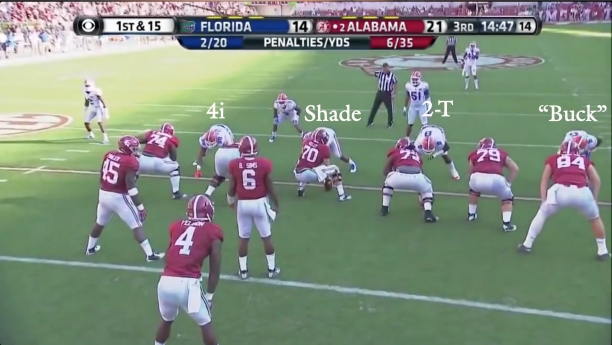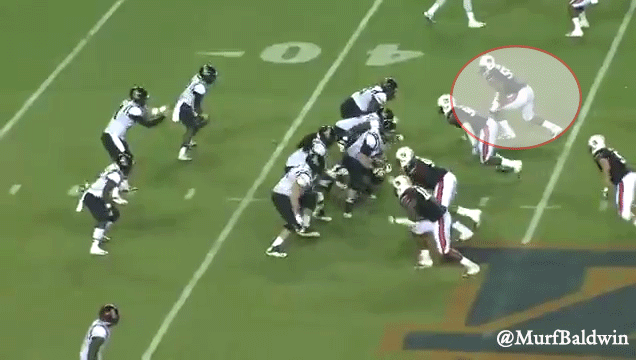Film Study: Auburn about to unleash a beast in hybrid DE Carl Lawson
By Murf Baldwin
Published:
When most go back and revisit the ultra-successful 2013 Auburn University season, a lion’s share of the praise will go to, at the time, first-year head coach Guz Malzahn (at Auburn) and his vaunted two-back, power scheme offense that drove defensive coordinators nuts.
Most coordinators were left trying to figure out how to stop quarterback Nick Marshall, running backs Tre Mason and Cameron Artis-Payne and receiver Sammie Coates from piling up video game-like yardage and points.
And rightfully so.
Malzahn’s innovation, which is more like an update of retro concepts, captured the imagination of the entire football landscape and provided many with a blueprint on just how to operate, schematically, for the foreseeable future.
He proved that an efficient, tempo-based scheme — built around a variety of power concepts — could not only allow you to jump out on opponents quickly, it could also allow you to sit on a lead.
What most didn’t pay attention to was the other side of the ball. It’s not because that side of the ball didn’t carry its weight, it was more of it playing the little brother to its big brother counterpart.
Personnel-wise, standouts Cassanova McKinzy, Robenson Therezie, Ryan Smith, Jonathon Mincy and Jermaine Whitehead proved that Auburn had talent on the second and third levels, however, it paled in comparison to what the Tigers had up front.
The interior rotation was on swole with the versatile Gabe Wright, Nosa Eguae and true freshman Montravius Adams. But it was the edge-presence of the mercurial Dee Ford, and the explosive true freshman Carl Lawson, that tied the entire operation together.
Fast forward to present day.
Auburn is now armed with the preeminent defensive mind in the business, new DC Will Muschamp, and a healthy Lawson who will now fill the role of Ford with uber recruit Byron Cowart filling his. When you take into account the presence of Adams, the versatile Gimel President and DeVonte Lambert, you can see why this Auburn front has a chance to make a difference with an offense that will probably pace the conference.
While many assumed the DC would team up with South Carolina’s Steve Spurrier, following his dismissal as the head coach of the Florida Gators, Muschamp made the correct decision to return to the Plains.
The personnel already matches his scheme.
Lawson A Scheme-specific Fit For An Aggressive, Multiple Defense
While most associate Muschamp with an odd-front defense due to his time spent under now famed 3-4-based savant Nick Saban, he’s held onto the concepts the pair mastered in Baton Rouge, La., when they were together as DC and head coach, respectively, for Louisiana State University.
It was there where they infused odd-front principles into an even-front alignment allowing for some serious versatility within their talented front.
But it was with the Miami Dolphins where they uncovered a hybrid gem in the form of veteran edge-player Jason Taylor — who had spent the previous decade as a traditional hand-in-the-dirt, 6-technique defensive end.
Muschamp’s 4-3 allows for some serious gap control and organic pressure due to the four down linemen.
Versatility is the key to a Muschamp-led defense as he cross-pollinates his front seven players to oscillate between odd- and even-front principles. Interior linemen have to be able to play anywhere from a 0- to a 5-technique alignment, while edge-players have to be able to rush from a two- or three-point stance and play in reverse as coverage duties are required in certain packages.
Current New England Patriots rookie, and former interior player for Florida, Dominique Easley most exemplified this theory under Muschamp. He could literally play the nose or a “Wide 9″ end.
The primary position on the defense is a hybrid edge-player called a “Buck.” Future NFL star Dante Fowler played this position as well as Muschamp could’ve imagined the past couple of season; his ability to rush, drop in zone and play a plethora of positions tied the entire defense together.
This was a brief defensive explanation I wrote on Muschamp’s scheme after he was hired in December. I’m going to concentrate on the “Buck” position as it will be the money position in the Tigers’ scheme and recruiting efforts will reveal that.
In order for a player to play in this position he must be north of 250 pounds and possess the ability to play in reverse. While many have detailed this position as one that operates out of a two- or three-point stance, depending on the alignment, it goes much deeper than that philosophically.
The Buck normally plays toward the strength of the alignment — meaning you will usually see him being deployed where the “Y” position is aligned — but if the offense is in something like “Red” personnel (one back, four receivers in the Gun), the Buck will play to the opposite side of the back. If the offense goes with “00” personnel, the Buck will put his hand in the dirt and hunt from the quarterback’s blind side.
(Of course, pre-snap shifts and motions are designed to throw off assignment football so all that could change at a moment’s notice.)
Since the Buck plays the closed side of the offensive formation he has to be above solid against the run — hence Fowler’s 261-pound frame — and have the ability hold contain and funnel the play back toward the action.
Fowler lined up over the “Y” at the Buck
With Fowler being drafted No. 3 overall in this past draft, Muschamp will have a lot of selling power behind him on the recruiting trail; he will now turn Lawson into that same exact beast.
Lawson, 6’2″, 257 pounds, is almost a clone of Fowler Jr. in everything from size to skill set; he excels at run defense and works from power moves in the passing game. As a composite 5-star recruit from Alpharetta, Ga., Lawson burst on the national scene after recording an astounding 27 sacks for Milton High School in 2012.
Many had dreams of him tearing it up for the hometown University of Georgia in its attacking 3-4-based scheme as a stand up rush linebacker, but he chose to play for incoming DC Ellis Johnson in his traditional 4-2-5 scheme where he would virtually always put his hand in the dirt and get upfield.
Now he has a chance to do both.
Just look at the explosiveness from the 260-pound athlete: He showed fantastic agility in converting speed to power in running the arc against much-heralded left tackle Laremy Tunsil of Ole Miss; he displayed relentlessness in corralling the the QB darn near across the formation.
Here we see Lawson using his F.B.I. (football intelligence): on a zone-read play, where Lawson was rendered the unblocked defender the play was keyed on, he used aggression in approaching the QB and running back at the mesh point, but he slow played it to the point where he forced a late decision, which resulted in a sack.
Lastly, we see Lawson converting speed to power by using sound technique: great hand placement, excellent body lean and pad-level. It’s rare for a person his size to have such a quick take-off move, too. His ability to play in the lap of the QB undoubtedly has Muschamp up at night thinking of ways to deploy him and the rest of his talented front.
And that’s not taking into account they have a Lawson clone in the 6’4″, 258-pound Byron Cowart — a composite 5-star recruit as the No. 1 edge-rusher in the nation. Lawson is on the mend from a season-ending knee injury that robbed him of his sophomore campaign, but by most accounts he’s revved up and ready to go.
This kid is about to wreck shop in that Muschamp scheme.
Former linebacker/safety Murf Baldwin specializes in diving deep into the Xs and Os of the game with the goal of educating and entertaining while bringing fans closer to their team.











